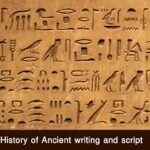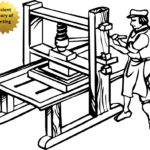In the early stages of civilization, people had little interest in writing. Initially, their primary focus was on survival, battling the challenges posed by nature to protect their lives. Between 6000 and 3000 BC, there was a shift towards urban civilization. With the rise of urban centers, the temples and palaces of Mesopotamia and Egypt became significant sources of wealth. Before this, records of wealth were maintained in memory. However, as wealth increased, it became increasingly difficult to manage large accounts solely through oral means. This challenge led to the development of systematic record-keeping.
The first form of writing in civilization can be seen as the beginning of this record-keeping practice. In the early stages, symbols and pictures were used to represent accounts. For instance, if someone borrowed five coins and then needed to give them back to someone else, they might draw a picture of five sheep alongside their record to denote the amount. This early form of account-keeping is more accurately described as an invention rather than true writing.

Cuneiform Script:
The cuneiform script, invented by the ancient Sumerians around 3500 BC, is one of the earliest forms of writing. This phonetic alphabet evolved from hieroglyphs, and the earliest examples clearly demonstrate its unique structure. The script captured the history of various objects and animals, and researchers widely agree that it originated from pictorial symbols.
Over time, these images became enriched with consonants, with each symbol representing a word or group of words. The representations transformed significantly; for instance, a hieroglyph depicting a human head may have evolved into different symbols that could not be understood without contextual explanation. The Sumerians used these writings to signify concepts such as “human head,” employing the Sumerian language to convey meaning through this uniform script.
Hieroglyphic Script:
Hieroglyphic script was introduced in ancient Egypt in the late fourth millennium BC. This script, derived from pictographs, served as a phonetic system, although it was based on letters. The characters or symbols of hieroglyphic script depict real objects such as birds, people, whips, and various other items. However, these characters do not represent a direct phonetic pathway; instead, they are diverse symbols. For instance, the image of an owl can symbolize a cup.
Thyroglyphics is an example of a script inspired by hieroglyphics. Over time, hieroglyphics developed significantly, resulting in a mixture of ideas and rich symbolism. Different symbols were gradually employed in hieroglyphic writing to express various consonant sounds. However, there were no strict rules regarding how many symbols represented a single consonant sound or how many combined to form two or more sounds. The script includes 24 symbols for single consonant sounds and 75 symbols for combinations.
Many people believed that the primary alphabet was derived from hieroglyphics, but in reality, the symbols for single consonant sounds in the Hieroglyphic script were not standardized. Additionally, single consonant sounds were represented by various symbols, making it impossible to use hieroglyphic writing as a true alphabet.
Hieroglyphic writing was typically oriented from right to left, although it could sometimes be written from left to right. This script was well-suited for the ancient Egyptian language and was compatible with it. While many peoples in the Middle East and West Asia adopted the cuneiform script from Mesopotamia to express their own languages, the Gnostic script remained unique and could not serve as a vehicle for any language other than Egyptian.
Hieratic and Demotic Script:
Two other types of scripts that emerged in ancient Egypt are known as Hieratic and Demotic scripts. These scripts are not independent; rather, they are adaptations of hieroglyphic scripts. Hieroglyphic writing was primarily used for royal and religious purposes, often inscribed on the walls of temples and pyramids, which required maintaining its aesthetic form. As a result, hieroglyphics were not practical for everyday use. To address the need for a more simplified writing system for business and other practical activities, Hieratic script was developed first. Over time, as demand for even simpler writing increased, Hieratic gradually fell out of use, leading to the development of Demotic script. Demotic was in use from the seventh century BC to the fifth century BC.
The Phoenicians Script:
The region inhabited by Semitic peoples, excluding the Babylonians and Assyrians, is known as the “Fertile Crescent.” The Phoenicians are the most prominent among these peoples. This area, located between Syria and the distant sea, spans approximately 12 miles in length and 10 miles in width, and in ancient times, it was referred to as ‘Phoenicia.’
The Phoenicians were primarily merchants. Their most important trade item was papyrus, which they imported from Egypt and exported throughout the Mediterranean region. It is believed that the Phoenicians not only exported papyrus but also brought the Egyptian alphabet with them. Their contributions to the spread of education, culture, and knowledge are well remembered in history. The alphabets they disseminated influenced regions such as Egypt, Crete, and Syria. Their adaptations of these alphabets laid the groundwork for the development of the European alphabet.
Although the Phoenicians were not a literate people, their main focus was on trade and commerce, particularly in commercial transactions and accounting. Nonetheless, they played a significant role in the development of a cursive writing system and in promoting the use of papyrus over the traditional clay tablets, a contribution that is universally acknowledged.
From survival records to structured alphabets, ancient inscriptions such as cuneiform, hieroglyphics, hieratic, demotic, and Phoenician scripts marked the evolution of human communication. Each system reflected the needs of its society—whether for trade, religion, or administration—and together, they preserved knowledge, shaped cultures, and laid the groundwork for modern writing systems and global literacy.



